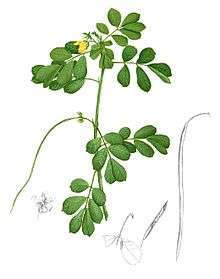Senna tora
- This page is about the Cassia tora described by Linnaeus. Later authors usually applied the taxon to Senna obtusifolia.
| Senna tora | |
|---|---|
 | |
| Scientific classification | |
| Kingdom: | Plantae |
| (unranked): | Angiosperms |
| (unranked): | Eudicots |
| (unranked): | Rosids |
| Order: | Fabales |
| Family: | Fabaceae |
| Subfamily: | Caesalpinioideae |
| Tribe: | Cassieae |
| Subtribe: | Cassiinae |
| Genus: | Senna |
| Species: | S. tora |
| Binomial name | |
| Senna tora (L.) Roxb. | |
| Synonyms | |
|
Numerous, see text | |
Senna tora (originally described by Linné as Cassia tora) is a legume in the subfamily Caesalpinioideae. Its name has been derived from Sinhala language, in which it is called Tora (තෝර). In Sri Lanka it is easily found in many places. It grows wild in most of the tropics and is considered a weed in many places; its native range is not well known but probably South Asia. It is often confused with Chinese senna or sicklepod, Senna obtusifolia. If it is given a distinct common name at all, it is called sickle wild sensitive-plant[1] or sickle senna.[2]
Use
This herb is used in Ayurveda for treatment of swellings. In some parts of Sri Lanka, people add its flowers in food.
Synonyms
The taxonomic history of this plant is extremely confused, even by the standards of Senna and Cassia. S. tora and S. obtusifolia were for long and are often still held to be—and may eventually be verified as—a single species. Hence, taxa referring to either species were indiscriminately applied to both.[3]
- Cassia boreensis Miq.
- Cassia borneensis Miq.
- Cassia gallinaria Collad.
- Cassia numilis Collad.
- Apparently a misprint for Cassia humilis, which would have been applied to this species in error as it is properly a synonym of Senna obtusifolia and Chamaecrista kunthiana, depending on the author.
- Cassia tora L.
- As discussed above, the Cassia tora of other authors refers to Senna obtusifolia
- Cassia tora L. var. borneensis (Miq.) Miq.
- Cassia tora L. var. b, var. humilis, and var. obtusifolia all refer to Senna obtusifolia
- Emelista tora Britton & Rose
Habitat
The seeds can be found in forest and tribal area of India, Sri Lanka, China and other Asian countries.
Footnotes
- ↑ NatureServe (2007)
- ↑ "Senna tora". Natural Resources Conservation Service PLANTS Database. USDA. Retrieved 10 November 2015.
- ↑ ILDIS (2005)
References
- International Legume Database & Information Service (ILDIS) (2005): Senna tora (L.) Roxb.. Version 10.01, November 2005. Retrieved 2007-DEC-20.
- NatureServe (2007): Senna tora (L.) Roxb. species factsheet. Version 6.3, 2007-OCT-29. Retrieved 2007-DEC-20.